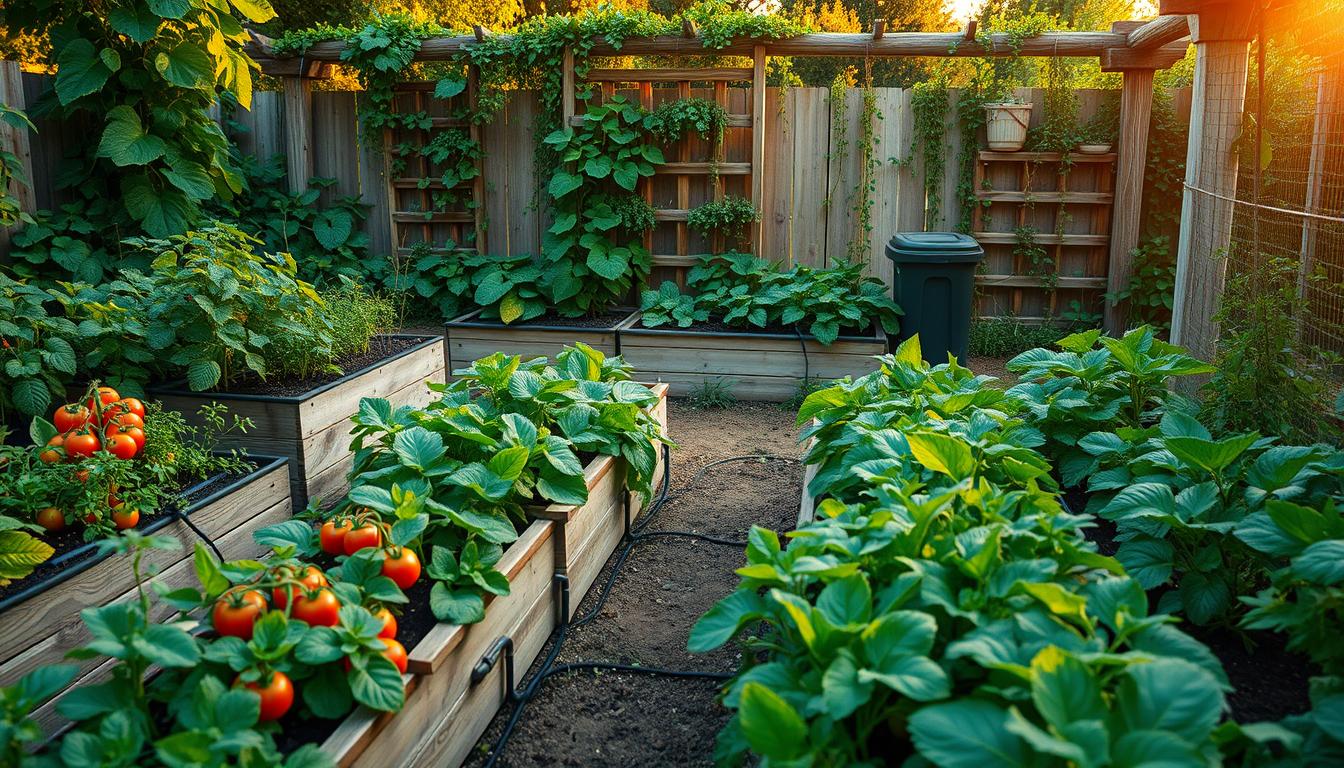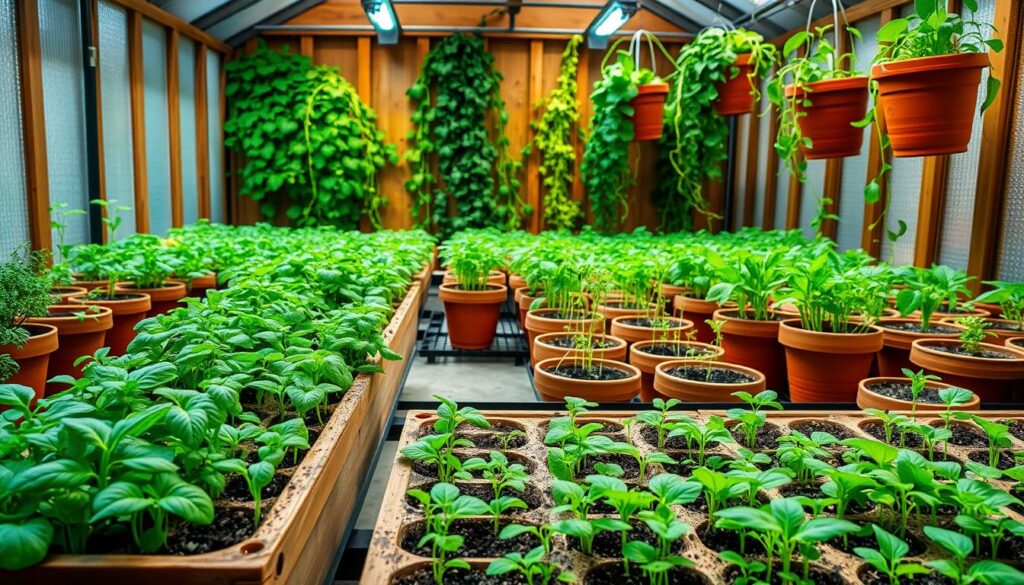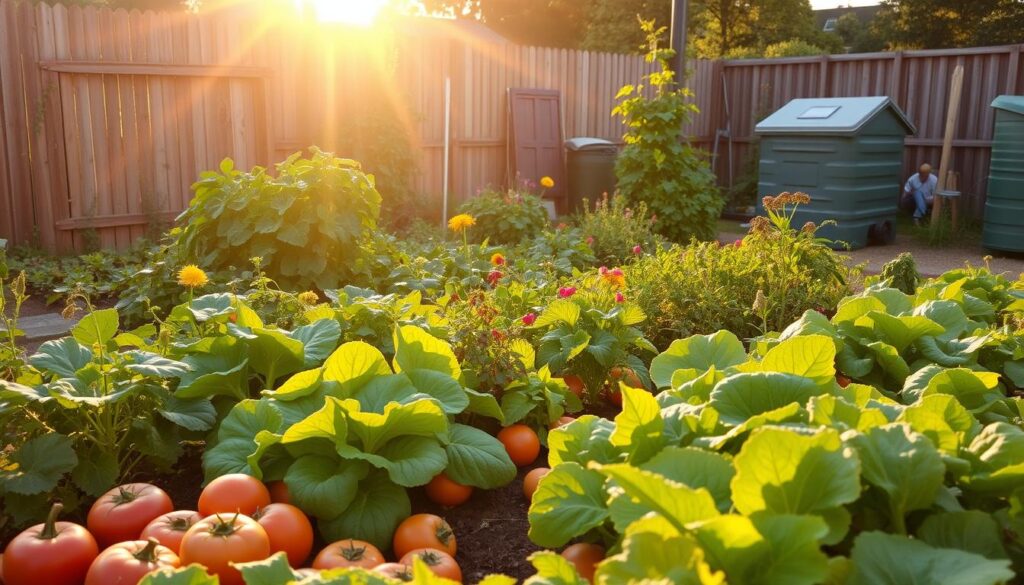
Veggie Garden Hacks You NEED
Ever wonder why some gardens do well while others don’t? Discover the veggie garden hacks you need to grow more veggies with less effort! These smart gardening tips turn any plot into a productive space. Say goodbye to wasted seeds and wilting plants with these time-saving tricks.
Imagine a garden that gives you fresh produce without the hassle. This guide shares garden hacks like soil secrets, space-saving layouts, and pest-free strategies. Learn to plan, plant, and protect your crops with everyday items and smart timing. Ready to make your garden great? Let’s start with the first steps to success.
From seed to harvest, these gardening tips make it easy. Find out how simple changes can boost flavor, extend seasons, and reduce frustration. Your garden’s potential is waiting—let’s unlock it together!
Getting Started: Essential Veggie Garden Planning Hacks
Starting a thriving vegetable garden begins with smart planning. Whether you’re designing a small backyard space or a larger garden yard, these tips simplify the setup process. First, map your garden’s sunlight patterns to choose the best spots for vegetables. Next, test soil without breaking the bank using easy methods. Lastly, pick a layout that saves time without sacrificing growth.
Mapping Your Garden for Maximum Sun Exposure
Most vegetables need 6-8 hours of sunlight daily. Observe your yard at different times to spot sunny and shady zones. Use free apps like PlantSnap to track sun patterns. Match plants to their light needs: tomatoes and peppers in sunny spots, leafy greens in partial shade.
Soil Testing Shortcuts for Better Growth
Test soil pH and nutrients with DIY methods. Mix vinegar and baking soda into soil samples to check acidity. For nutrients, use a Mail-in Soil Test Kit from Home Depot. Adjust based on results—add compost for poor soil or lime for acidic patches.
Time-Saving Layout Designs for Busy Gardeners
Choose layouts that cut work without reducing yield. Here’s a quick comparison:
| Layout | How It Works | Best For |
|---|---|---|
| Raised Beds | Use stacked wood or bricks for elevated plots | Small spaces, easy access |
| Keyhole Gardens | Compact circular beds with a compost core | Urban backyard vegetable garden tips |
| Square Foot Gardening | Divide plots into 1-foot grids for crop rotation | Beginners and space-saving garden yard ideas |
Pair these hacks with mulch to retain moisture and reduce weeding. Plan smart, and your garden will grow stronger with less effort.
Space-Maximizing Tricks for Any Garden Size
Even small veg gardens can thrive with smart space-saving strategies. Use vertical spaces by hanging herbs and strawberries in gutters or on pallets. Shoe organizers on walls can hold lettuce or cherry tomatoes, adding beauty to your home vegetable garden.

- Vertical Gardens: Attach gutters or planters to fences; they’re perfect for beans and peas.
- Interplanting: Pair fast-growing greens like radishes with slow-growing carrots—harvest the radishes first, freeing space for carrots.
- Containers: Repurpose buckets, tires, or crates as planters for peppers or herbs. Drainage holes and soil mixes make these work.
Square foot gardening, started by Mel Bartholomew, divides beds into 12-inch sections. This maximizes vegetable gardens in tight spaces. Apartment dwellers can use window boxes or stackable pots. Balconies become mini-farms with tiered plant stands.
No yard? Even a sunny windowsill can grow microgreens or sprouts. These tricks show that size isn’t a limit—creativity can grow more food in less space. Try one hack today and watch your garden flourish.
Smart Seed Starting Techniques That Guarantee Success
Learning to start seeds is crucial for a thriving growing veggies at home. These gardening tips help beginners become pros, making sure every seed grows well. Let’s explore simple ways to make your garden grow.
Paper Towel Germination Method
Speed up sprouting for tough seeds like peppers or tomatoes. Place damp paper towels over seeds, seal in a bag, and keep warm. Check every day—most sprout in 3–7 days. When roots show, move them to soil carefully. This method is great for garden inspo and works best at 70–85°F. Use a heating pad if it’s too cold.

Repurposed Household Items as Seed Starters
Make planters from trash! Egg cartons are perfect for starting seeds. Roll newspaper into pots using a glass or can. No need for plastic. Toilet paper rolls can go straight into soil, avoiding shock. These ideas save money and reduce waste, fitting eco-friendly gardening tips for any space.
Timing Hacks for Continuous Harvests
Get the most from your garden with smart planting. Use a calendar to plan sowings every 2–3 weeks for crops like lettuce or beans. For instance, plant spinach in early spring and again in late summer for fall harvests. Keep track of frost dates and adjust planting times for your USDA zone. This way, you avoid overcrowding and enjoy fresh produce all season.
Water-Wise Solutions for Sustainable Veggie Gardens
Water is precious—very important for a vege garden. Using water wisely saves time, resources, and plants. Start with drip irrigation: poke holes in recycled plastic bottles to slowly soak roots. Soaker hoses, buried 1-2 inches deep, deliver water straight to soil, cutting waste by up to 50%.

Try these organic gardening tricks to keep soil moist longer. Mulch with straw, shredded leaves, or even newspaper. This traps moisture and fights weeds. Here’s what works best:
| Mulch Type | Moisture Retention | Best For |
|---|---|---|
| Straw | High | Vegetables like tomatoes and peppers |
| Coffee Grounds | Moderate | Acid-loving plants (e.g., blueberries) |
| Wood Chips | Long-lasting | Border plants and perennial beds |
Harvest rainwater using barrels or buckets. A 55-gallon drum catches runoff from roofs—perfect for watering during dry spells. Water early morning to reduce evaporation. Pair with deep, infrequent soakings to encourage strong roots. These sustainable gardening techniques mean less work and healthier plants, even in droughts.
Veggie Garden Hacks You NEED for Pest Control
Pests don’t stand a chance with these smart, chemical-free strategies. Protect your plants with vegetable garden hacks that keep bugs away without harming the environment. This section covers three key approaches: companion planting, homemade deterrents, and simple barriers that work wonders.

Companion Planting Strategies That Actually Work
Pair plants that work together. Marigolds near tomatoes repel nematodes, and basil near peppers confuses aphids. These organic gardening tricks rely on scent or attracting predators. Try these combos:
- Marigolds + tomatoes (repels nematodes)
- Basil + peppers (deters aphids)
- Nasturtiums + cucurbits (attract beneficial insects)
DIY Natural Pest Deterrents Using Kitchen Scraps
Turn kitchen scraps into powerful tools. Crushed eggshells around plants stop slugs. Mix garlic and dish soap in water for a spray against beetles. Use citrus peels soaked in water as a natural repellent. These methods use items you already have.
- Garlic spray: 1 cup water, 10 minced cloves, 1 tsp dish soap. Let sit 24 hours, then spray plants.
- Citrus peel soak: Boil orange peels in water, let cool, then spray soil.
Physical Barriers That Protect Without Chemicals
Create shields with household items. DIY garden solutions like copper tape around plant beds shocks slugs. Old pantyhose over broccoli keeps moths away. Floating row covers block insects without chemicals. These setups save time and money.
- Copper tape: Stick to planters to stop slugs
- Pantyhose: Cover broccoli heads to block moth larvae
- Floating row covers: Drape over plants with clips
Combine these methods for a garden that stays pest-free naturally. No chemicals mean healthier soil and tastier harvests.
Soil Enhancement Shortcuts for Nutrient-Rich Gardens
Healthy soil is key for a potager garden to flourish. Use everyday items to make natural fertilizers. Crush coffee grounds and eggshells to add nitrogen and calcium to the soil. Autumn leaves make great mulch, improving texture and drainage.
Try trench composting to speed up composting. Dig a shallow hole, add veggie scraps, and cover with soil. This garden hack feeds the soil and keeps odors down. For quick nutrients, make compost tea by steeping compost in water. Use this liquid to water your plants.
- Use clover or winter rye as green manures. Till them under in spring to add organic matter.
- Test soil pH yearly to adjust amendments. Acidic soils benefit from wood ash; alkaline soils thrive with sulfur.
Soil needs differ by region. In dry areas, mix sand with compost for better drainage. In wet places, add perlite to prevent waterlogging. Use cover crops like buckwheat to protect and feed the soil during off-seasons.
| Soil Type | Key Amendment | Key Benefit |
|---|---|---|
| Sandy | Compost + peat moss | Moisture retention |
| Clay | Coarse sand + shredded leaves | Aeration improvement |
| Loamy | Compost tea | Nutrient replenishment |
Turning scraps into soil food creates a self-sustaining cycle. These methods make fertile beds without buying products. Watch for changes weekly. Soil that crumbles easily is ready for planting. Let nature help, and watch your plants grow.
Harvesting and Storage Innovations
Get the most out of your veggie garden by learning how to store your harvest. Knowing when and how to store your veggies turns your garden into a year-round food source. Start by picking your veggies in the early morning for the best taste and freshness.
Timing Your Harvest for Peak Flavor
- Tomatoes: Pick when fully colored and slightly soft—never let frost touch them.
- Leafy greens: Harvest outer leaves to let inner ones grow; spinach tastes best before leaves yellow.
- Herbs: Snip basil and cilantro in morning dew for maximum aroma retention.
Refrigeration Tricks to Extend Produce Life
Not all veggies do well in the fridge. Here’s a guide to keep your garden fresh:
| Vegetable | Storage Method | Tip |
|---|---|---|
| Carrots | Refrigerate in damp sand or cloth | Keeps crisp up to 3 months |
| Onions | Hang in mesh bags in a cool, dark spot | Avoid refrigeration to prevent sogginess |
| Leafy greens | Wrap in paper towels before refrigerating | Moisture control extends life by 50% |
Preservation Methods for Garden Abundance
Try these simple techniques:
- Freezing: Puree excess tomatoes into sauce; freeze in ice cube trays for later use.
- Quick pickle: Submerge cucumbers in vinegar brine for 24 hours for instant pickles.
- Dehydration: Dry herbs on screens or use an oven at 175°F for 2-3 hours.
These methods help you enjoy your garden all year. Adjust them to fit your kitchen and eating habits!
Urban Gardening Hacks for Limited Spaces
Urban gardening is turning small areas into food gardens. You don’t need a backyard to grow veggies at home. Balconies, windowsills, and rooftops can be used with clever ideas.
Begin with light containers and choose compact plants like patio tomatoes or microgreens. Look for veggies made for small spaces. Nurseries have varieties like ‘Tiny Tim’ tomatoes or ‘Spacemaster’ cucumbers. They grow well in tight spots and give fresh food.
- Vertical systems like wall-mounted planters save floor space.
- Use stackable pots or hanging baskets for herbs and strawberries.
- Community garden plots or shared courtyards provide more space if renting—many cities offer public garden programs.
- Repurpose items like old pallets or buckets as planters to cut costs.
Many gardeners use fire escapes (where allowed) for growing. A New York City resident grows salad greens and cherry tomatoes on their balcony. They share with neighbors. These stories show how small areas can produce a lot.
Online, you can find lots of garden ideas. Hashtags like #BalconyGarden show off creative gardens. Use self-watering containers or aeroponic kits for easier care. Even a sunny windowsill can grow basil or peppers.
Start small, try new things, and watch your space become a productive garden. Every plant helps make the city greener and your food tastier.
Transform Your Gardening Experience: Putting These Veggie Hacks into Action
Start with one or two hacks to see what works for your space. Try building a raised bed from reclaimed wood—it’s a diy garden solutions idea that saves time. It fits any vegetable garden design, even in small yards. First, check your garden’s needs: soil health, sun, and timing.
In spring, focus on soil testing and picking seeds. Summer is for pest control with companion planting or DIY sprays. Autumn is for saving harvests and planning next year. Adjust your methods based on your climate. Use sustainable gardening techniques like water-wise irrigation or composting gradually.
Short on time? Use vertical gardening to save space or grow quick crops. On a budget? Use household items for seed starters or mulch. Keep track of your successes and challenges in a journal. What works in one garden might need changes elsewhere—adapt as you learn.
Gardening evolves with each season. Experiment, observe, and refine. Whether you’re tweaking a vegetable garden design or mastering composting, every step builds confidence. Embrace the trial-and-error journey. Celebrate small wins, like your first harvest from a recycled planter or a pest-free row. These hacks are tools, not rules—use them to create a garden that fits your lifestyle and environment. Happy planting!
Leave a Reply